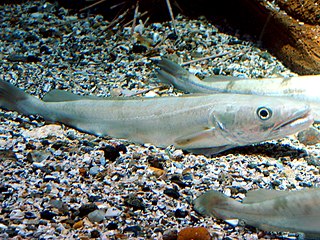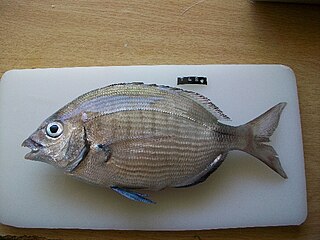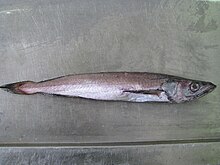
Hake is the common name for fish in the Merlucciidae family of the northern and southern oceans and the Phycidae family of the northern oceans. Hake is a commercially important fish in the same taxonomic order, Gadiformes, as cod and haddock.

The Zeidae are a family of large, showy, deep-bodied zeiform marine fish—the "true dories". Found in the Atlantic, Indian, and Pacific Oceans, the family contains just six species in two genera. All species are important and highly regarded food fish supporting commercial fisheries, and some—such as the John Dory —are enjoyed in large public aquaria. These fish are caught primarily by deep-sea trawling.

The Atlantic horse mackerel, also known as the European horse mackerel or common scad, is a species of jack mackerel in the family Carangidae, which includes the jacks, pompanos and trevallies. It is found in the eastern Atlantic Ocean off Europe and Africa and into the south-eastern Indian Ocean. It is an important species in commercial fisheries and is listed as a Vulnerable species on The IUCN Red List of Threatened Species.

Demersal fish, also known as groundfish, live and feed on or near the bottom of seas or lakes. They occupy the sea floors and lake beds, which usually consist of mud, sand, gravel or rocks. In coastal waters, they are found on or near the continental shelf, and in deep waters, they are found on or near the continental slope or along the continental rise. They are not generally found in the deepest waters, such as abyssal depths or on the abyssal plain, but they can be found around seamounts and islands. The word demersal comes from the Latin demergere, which means to sink.

The North Pacific hake, Pacific hake, Pacific whiting, or jack salmon is a ray-finned fish in the genus Merluccius, found in the northeast Pacific Ocean from northern Vancouver Island to the northern part of the Gulf of California. It is a silver-gray fish with black speckling, growing to a length of 90 cm (3 ft). It is a migratory offshore fish and undergoes a daily vertical migration from the surface to the seabed at depths down to about 1,000 m (3,300 ft).

Emmelichthys nitidus, the Cape bonnetmouth, bonnetmouth, redbait, pearl fish, picarel, red baitfish, red herring or Southern rover, is a species of marine ray-finned fish belonging to the family Emmelichthyidae, the rovers and bonnetmouths. This species is found in the Indian and Pacific oceans. This species is of minor importance to commercial fisheries.

Mullus barbatus is a species of goatfish found in the Mediterranean Sea, Sea of Marmara, the Black Sea and the eastern North Atlantic Ocean, where its range extends from Scandinavia to Senegal. They are fished, mostly by trawling, with the flesh being well regarded. The International Union for Conservation of Nature has assessed their conservation status as being of "least concern".

Merluccius is a genus of merluccid hakes from the Atlantic and Pacific Oceans, where mainly found relatively deep.

Merluccius merluccius, the European hake, is a merluccid hake of the genus Merluccius. Other vernacular names include Cornish salmon and herring hake. It is a predatory species, which was often netted alongside one of its favoured prey, the Atlantic herring, hence the latter common name. It is found in the eastern Atlantic from Norway and Iceland south to Mauritania and into the Mediterranean Sea. It is an important species in European fisheries and is heavily exploited, with some populations being fished unsustainably.

Merluccius gayi is a merluccid hake of the genus Merluccius, with two subspecies, the South Pacific hake or Chilean common hake and the Peruvian hake, found in the south-western Pacific Ocean, along the coast of South America, from Peru to the Chilean coasts north to the Chiloé Archipelago. During the Southern Hemisphere summer, it migrates southwards in shallow waters, while in the winter, it lives more to the north, in far deeper waters.
Merluccius paradoxus, the deep-water Cape hake, is a merluccid hake of the genus Merluccius, found in the south-eastern Atlantic Ocean, along the coast of Southern Africa, south of Angola. Its range extends in decreasing abundance around the southern coast of Africa and into the Indian Ocean, but it is at its most plentiful in the cold, nutrient-rich fishing grounds of the Benguela Current.

The Cape horse mackerel is a mackerel-like species in the family Carangidae. It is a pelagic species of the south eastern Atlantic Ocean which is a target of fisheries, mainly as bycatch.
The Panama hake, also known as the dwarf hake, is a merluccid hake found off the west coast of the Americas from Del Mar, California, to Ensenada de Tumaco, Colombia.
The South African Deep-Sea Trawling Industry Association (SADSTIA) represents the trawler owners and operators active in the offshore demersal trawl fishery for hake, the most valuable of South Africa's commercial fisheries, contributing approximately 45 percent of the value of fishery production. Based in Cape Town, South Africa, SADSTIA currently has 32 members that catch, process and market the Cape hakes, Merluccius paradoxus and Merluccius capensis as well as several bycatch species.
Merluccius australis, the southern hake, is a species of fish from the family Merlucciidae, the true hakes. It is found in the southern Pacific and Atlantic Oceans with two disjunct populations, one around southern South America and the other in the waters around New Zealand.
Merluccius polli, the Benguela hake, is a species of fish from the family Merlucciidae, the true hakes. It is found in the tropical waters of the eastern Atlantic Ocean off the west coast of Africa.
Merluccius senegalensis, the Senegalese hake, is a species of fish from the family Merlucciidae, the true hakes. It is found in the sub tropical waters of the eastern Atlantic Ocean off the north western coast of Africa.

Argyrosomus inodorus, the mild meagre or silver kob, is a species of marine ray-finned fish belonging to the family Sciaenidae, the drums and croakers. The species is found off southern Africa where it is an important target species for hook and line fisheries.

Diplodus capensis, the Cape white seabream or blacktail seabream, is a species of marine ray-finned fish belonging to the family Sparidae, which includes the seabreams and porgies. This fish is found around the coasts of Southern Africa.

Stomias boa, also known as the boa dragonfish, scaly dragonfish, dragon-boa or boa scaly dragonfish, is a species of deep-sea fish in the family Stomiidae. It is found at great depths worldwide in tropical to temperate oceans but is absent from the northern Pacific and northwest Atlantic Oceans.
















